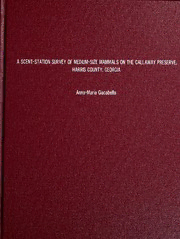
A Scent-Station Survey of Medium-Size Mammals on the Callaway Preserve, Harris County, Georgia PDF
Preview A Scent-Station Survey of Medium-Size Mammals on the Callaway Preserve, Harris County, Georgia
Digitized by the Internet Archive in 2012 with funding from LYRASIS Members and Sloan Foundation http://archive.org/details/scentstationsurvOOgiac — A Scent-Station Survey ofMedium-Size Mammals on the Callaway Preserve, Harris County, Georgia by Anna-Maria Giacobello A Thesis Submitted in Partial Fulfillment of Requirements ofthe CSU Honors Program for Honors in the degree of Bachelor in Biology, College ofScience, Columbus State University *^^=^g^^^-^«x- / > A^ f ° Thesis Advisor \_ Date U-j- Second Reader /SJU* \^\ Wo* Date^ Mat, ~i<mir ^ CSU Honors ProgramJpirector ^ W /L Lk fclfL—- Date I£ ft UlUCC> \ ) ( , j \i Abstract The objective ofthis project was to determine the relative abundance ofmedium- sized mammals on the Callaway Preserve in Harris County, Georgia, using the scent- station technique, to determine species preference in regard to habitat, to compare relative abundance ofspecies in regard to habitat, and to compare habitats in terms ofthe species present. Thirty-six scent-stations were established on the property and monitored to observe the presence ofcoyotes, raccoons, armadillos, foxes, opossums, and skunks. Of % the total number ofvisits to the scent-stations, 36.36 were coyotes, 18.18% were foxes 22.73% were armadillos, and 22.73% were raccoons. Only one opossum and no skunks visited the stations, thus the data was not included. The visitations offour species, coyotes, foxes, armadillos, and raccoons, were compared with respect to three types of habitat: Upland Hardwoods / Ridge, Upland Pines, and Mixed Hardwoods / Pines. The statistical significant difference in coyote observations suggested that they prefer the Upland Hardwoods / Ridge habitat. The lack ofstatistical, significant difference in other species observations suggested that these species have no habitat preference. The results indicated there was no significant difference in relative abundance ofthese species among these habitats. Also, the results indicated there was no significant difference in species richness among these habitats. Introduction Determining the abundance ofcertain species ofanimals is one ofthe major objectives ofmanagers and researchers in the field ofwildlife biology (Sargeant et al. 1998). Observing changes in animal abundances can be extremely important assessing changes ofhabitat, certain harvests ofland, and population variability (http://files.dnr.state.mn.us 2006). However, finding medium-sized mammals can be a problem as they are often in low population densities and inhabit secluded areas and techniques used to determine abundance can be costly and inaccurate (Sargeant et al. 1997, Sargeant et al. 1998, http://files.dnr.state.mn.us 2006). To save money and possibly provide more accurate results, surveys to determine the relative abundance ofa population are often employed. Usually indicated as an index, relative abundance is an estimate ofthe actual abundance ofa species in an area. A few techniques that have been used in numerous surveys to determine relative abundance include species identification through scat, hair snares, cameras, and scent-stations using sand or soot (http://files.dnr.state.mn.us 1999). In 1994, researchers used previous scent-station surveys to analyze data on the relative abundance ofraccoons over the period ofa year and a half(Smith et al. 1994). In 2001, researchers in Nebraska used the technique to observe the relative abundance ofthe endangered Swift Fox (www.ngpc.state.ne.us 2001). Unexpectedly, there was a high number ofvisitations to their scent-stations. In 2005, scent-station surveys were conducted to determine ifa thick shrub layer would affect the abundance ofcoyotes in certain habitats (Guevara et al. 2005).
